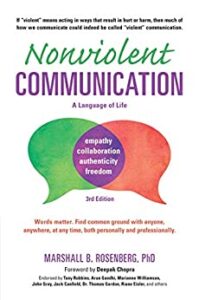Chapter 4 – Identifying and Expressing Feelings, page 37.
- The first component of NVC is to observe without evaluating; the second component is to express how we are feeling.
- “The mature person is able to differentiate feelings into as many nuances, strong and passionate experiences, or delicate and sensitive ones as in the different passages of music in a symphony.” – Rollo May (Psychoanalyst)
- For many of us, however, our feelings are, as May would describe it, “limited like notes on a bugle call.”
The Heavy Cost of Unexpressed Feelings
- Our repertoire of words for calling people names is often larger than our vocabulary of words to clearly describe our emotional states.
- Growing up, we are trained to be “other-directed” rather than to be in contact with ourselves. We learn to be “up in our head,” wondering, “What is it that others think is right for me to say or do?”
- When we follow the “feel” with the word “that” we are expressing an opinion but not revealing our feelings.
- This difficulty in identifying and expressing our feelings is common.
- Many professions (military, police, lawyers, engineers, corporate managers, etc.) discourage employees from expressing their emotions.
- I have often heard people say they cannot imagine ever expressing feelings at their workplace.
- The benefits of strengthening our feelings vocabulary are evident not only in intimate relationships but also in the professional world.
- Often, simply expressing our vulnerability can help resolve conflict.
Feelings versus Non-Feelings
- A common confusion, generated by the English language, is our use of the word feel without actually expressing a feeling.
- Often the words “I feel” could be more accurately replaced with the words “I think.” This helps us distinguish feelings from thoughts.
- In general, feelings are not being clearly expressed when the word “feel” is followed by:
- Words such as that, like, as if:
- “I feel that you…”
- “I feel like…”
- “I feel as if…”
- The pronouns, I, you, he, she, they, it:
- “I feel I am…”
- “I feel it is…”
- Names or nouns referring to people:
- “I feel Amy…”
- “I feel my boss is…”
- It is helpful to differentiate between words that describe what we think others are doing around us, and words that describe actual feelings.
- The following are examples of statements that are easily mistaken as expressions of feelings:
- “I feel unimportant to the people with whom I work.” The word “unimportant” describes how I think others are evaluating me, rather than an actual feeling, which in this situation might be “I feel sad” or “I feel discouraged.”
- “I feel misunderstood.” Here the word “misunderstood” indicates my assessment of the other person’s level of understanding rather than a feeling. In this situation, I may be feeling anxious or annoyed.
- “I feel ignored.” This is more of an interpretation of the actions of others than a clear statement of how we are feeling. No doubt there have been times we thought we were being ignored and our feeling was relief because we wanted to be left to ourselves. No doubt there were other times, however, when we felt hurt when we thought we were being ignored because we wanted to be included.
- Words like ignored express how we interpret others, rather than how we feel. Here are a sample of such words:
- Abandoned
- Attacked
- Betrayed
- Bullied
- Cheated
- Distrusted
- Interrupted
- Let down
- Misunderstood
- Overworked
- Pressured
- Rejected
- Taken for granted
- Threatened
- Unappreciated
- Unheard
- Unseen
- Unsupported
Building a Vocabulary of Feelings
- In expressing our feelings, it helps to use words that refer to specific emotions, rather than words that are vague and general.
- For example, if we say, “I feel good about that,” the word good could mean happy, excited, relieved, or a number of other emotions.
- Words such as good and bad prevent the listener from connecting easily with what we might actually be feeling.
- Please see the corresponding “Feelings Sheet” for a list of emotions compiled to help you increase your power to articulate feelings and clearly describe a whole range of emotional states.
Summary
- The second component necessary for expressing ourselves is feelings.
- By developing a vocabulary of feelings that allows us to clearly and specifically name or identify emotions, we can connect more easily to one another.
- Allowing ourselves to be vulnerable by expressing our feelings can help resolve conflicts.
- NVC distinguishes the expression of actual feelings from words and statements that describe thoughts, assessments, and interpretations.



